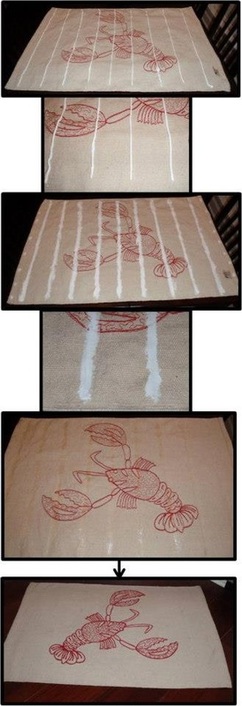
Hardwood floors and rugs can make for a slippery combination. But if you have as many rugs as I do, non-slip rug pads are a necessity - or at least they were.
Instead of using one of those ugly rug pads, try caulking the back of your rugs. Here's how I did it:
1. I used DAP clear premium indoor/outdoor sealant.
2. Using a caulk gun I made rows on the back of the rug. Thinking that the elevated rows would show once they were dry, or worse, that I might feel them once the rug was in place, I smoothed them down flat.
3. I let it dry for about 24 hours and voila! This rug literally doesn't move an inch from where I placed it on our hardwoods. Note to self: I probably could have done fewer rows in strategic places around the edge and middle since this is our kitchen rug and it gets a lot of traffic.
4. What I recommend to people who try this: Start with your smallest or most replaceable rug, just in case you don't like the results. Also, start with fewer rows-you can always add more. I don't know how this would work on other types of floors or other rug fibers, so please test a small spot before you go all out. I do not want to ruin anyones vintage floors or expensive rugs!
Easy and inexpensive! And the best part is that you don't have to worry about a rug pad peeking its ugly little head from beneath!
Update:
1. I found that the more traffic a rug gets, the more the rug holds to the floor (for low traffic areas I had to use more rows of caulking).
2. I washed this rug on cold and hung it to dry - it turned out beautifully. It did not alter the rows of caulking at all!
Instead of using one of those ugly rug pads, try caulking the back of your rugs. Here's how I did it:
1. I used DAP clear premium indoor/outdoor sealant.
2. Using a caulk gun I made rows on the back of the rug. Thinking that the elevated rows would show once they were dry, or worse, that I might feel them once the rug was in place, I smoothed them down flat.
3. I let it dry for about 24 hours and voila! This rug literally doesn't move an inch from where I placed it on our hardwoods. Note to self: I probably could have done fewer rows in strategic places around the edge and middle since this is our kitchen rug and it gets a lot of traffic.
4. What I recommend to people who try this: Start with your smallest or most replaceable rug, just in case you don't like the results. Also, start with fewer rows-you can always add more. I don't know how this would work on other types of floors or other rug fibers, so please test a small spot before you go all out. I do not want to ruin anyones vintage floors or expensive rugs!
Easy and inexpensive! And the best part is that you don't have to worry about a rug pad peeking its ugly little head from beneath!
Update:
1. I found that the more traffic a rug gets, the more the rug holds to the floor (for low traffic areas I had to use more rows of caulking).
2. I washed this rug on cold and hung it to dry - it turned out beautifully. It did not alter the rows of caulking at all!
 RSS Feed
RSS Feed
